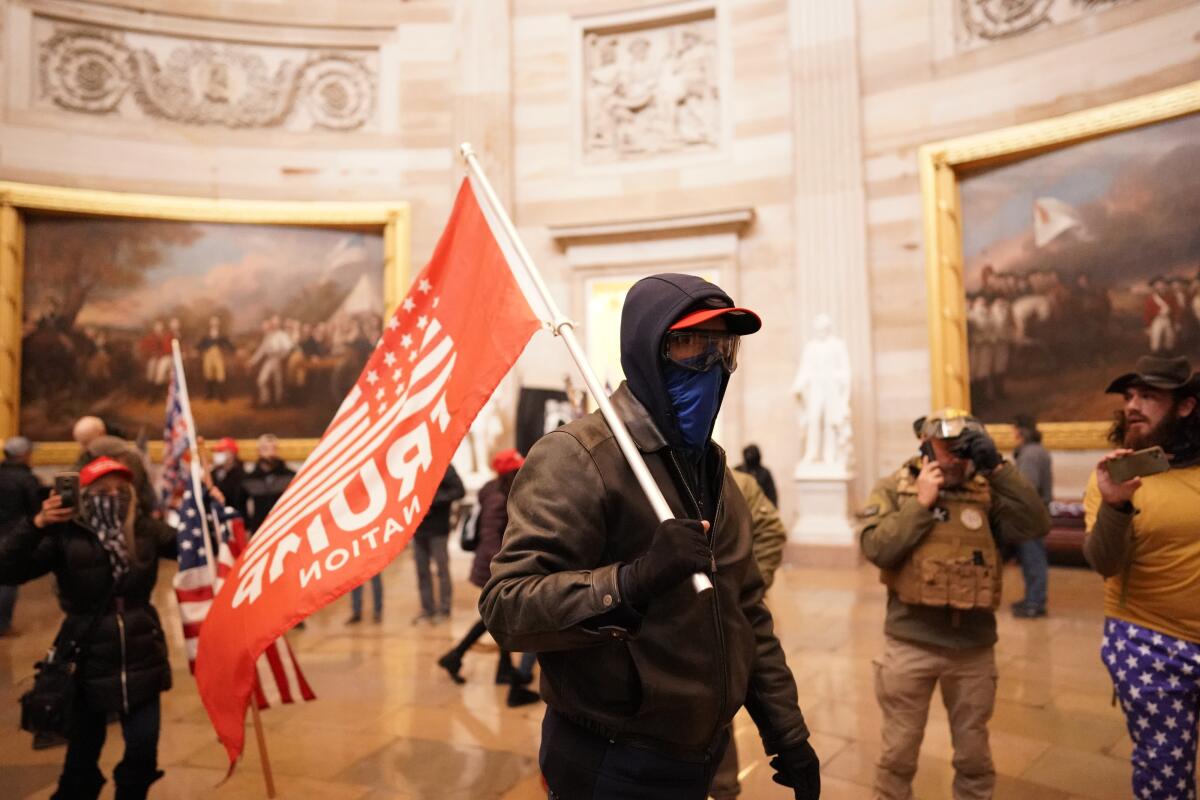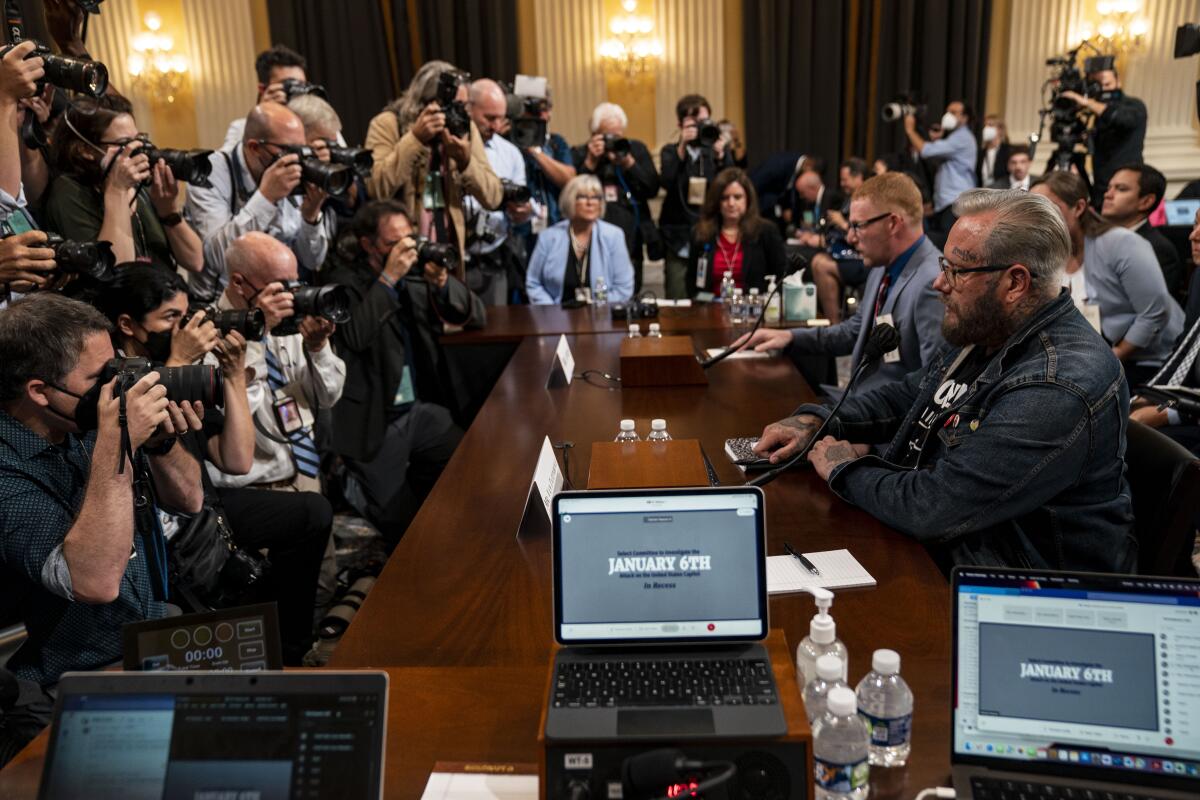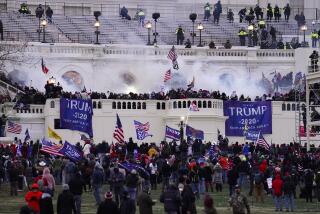The Jan. 6 committee’s focus on sedition, explained

- Share via
WASHINGTON — More than 800 people across the country have been charged with crimes related to the Jan. 6, 2021, attack on the U.S. Capitol, but only 16 have been charged with one of the country’s most serious crimes: seditious conspiracy. The Jan. 6 committee is expected to use its seventh public hearing Tuesday to make the case that former President Trump inspired some of these extremists to plot to assault the Capitol.
This past January, prosecutors charged 11 members of the Oath Keepers, a right-wing extremist group, with seditious conspiracy and other charges. During the Jan. 6 attack, five Oath Keepers, wearing “paramilitary clothing and patches with the Oath Keepers name, logo and insignia — marched in ‘stack’ formation up the east steps of the Capitol to the area outside of the Capitol Rotunda doors,” prosecutors allege. Stewart Rhodes, the group’s founder and leader, is among those charged. Rhodes and seven of the charged Oath Keepers have denied wrongdoing, but three have pleaded guilty.
“At 2:38 p.m., the doors were breached, and [the Oath Keepers stack] stormed into the Capitol alongside the mob,” the charging document states. Once inside, the original stack split into two groups with one “headed toward the House of Representatives, in search of Speaker of the House Nancy Pelosi.” Federal prosecutors also allege that Rhodes told his followers in an invite-only Slack channel on Dec. 11, 2020, that if then-President-elect Joe Biden were to be sworn in as president, “It will be a bloody desperate fight. We are going to have a fight. That can’t be avoided.” Rhodes used similar language in an interview on Dec. 22, 2020. If President Biden were to assume the presidency, “We will have to do a bloody, massively bloody revolution against them,” Rhodes told a fellow Oath Keeper. “That’s what’s going to have to happen.”
Prosecutors also charged Henry “Enrique” Tarrio, the leader of the right-wing extremist group the Proud Boys, and four members of his organization with seditious conspiracy; obstruction of an official proceeding; assaulting, resisting or impeding an officer; and destruction of government property, according to a June 6, 2022 charging document. Prosecutors allege that Tarrio created a special unit called the “Ministry of Self Defense” focused on the Capitol, and claim that group “conspired to prevent, hinder and delay the certification of the electoral college vote, and to oppose by force the authority of the government of the United States.” Tarrio and two other Proud Boys members have pleaded not guilty to seditious conspiracy. The other two Proud Boys accused of the crime have not yet been arraigned.

“On Jan. 6, 2021, the defendants directed, mobilized and led members of the crowd onto the Capitol grounds and into the Capitol, leading to dismantling of metal barricades, destruction of property, breaching of the Capitol building, and assaults on law enforcement,” prosecutors allege. “During and after the attack, Tarrio and his co-defendants claimed credit for what had happened on social media and in an encrypted chat room.”
Although it is not the same as treason — which involves actually levying war against the U.S. or helping enemies of the federal government — seditious conspiracy is a very serious charge and carries a 20-year maximum sentence.
Seditious conspiracy is an extremely rare and challenging crime to prosecute, as well. It is hard to prove, politically charged and requires federal prosecutors to show conspiracy amongst two or more members who agreed to use force to overthrow the government. The law was first enacted during the Civil War after Southern states succeeded from the Union.
Among previous seditious conspiracy cases was the 2010 prosecution of a Michigan militia group that was alleged to have plotted an uprising against the government. A judge threw out those charges after ruling that the prosecution’s case relied too heavily on speech protected by the 1st Amendment.
The Jan. 6 attack was not the first violent assault on Congress. In 1954, four pro-independence Puerto Ricans entered the Capitol and started shooting from the House gallery onto the chamber floor, wounding a number of representatives. The four people, along with a number of their co-planners, were convicted of seditious conspiracy.
More to Read
Get the L.A. Times Politics newsletter
Deeply reported insights into legislation, politics and policy from Sacramento, Washington and beyond. In your inbox three times per week.
You may occasionally receive promotional content from the Los Angeles Times.











